![]()
Experience as of mid April, 2013: Tracking as expected, with three dead after three years and nine months.
![]()
![]()
![]() The
ninth train-vehicle collision since opening occurred on August 3, 2010
(Seattle Times' Photo)
The
ninth train-vehicle collision since opening occurred on August 3, 2010
(Seattle Times' Photo)
Through April 2013, three pedestrians have been killed after being hit by light rail trains.
Light-rail-at-any-cost Seattle Transit Blog finally evaluates the argument made here as collisions begin to occur.
![]()

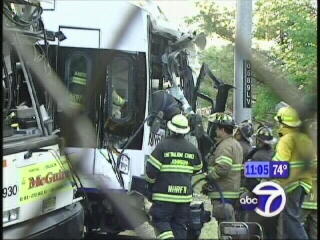 Thirteen people were
injured in August 2006 when a light rail train and a transit bus collided in
Weehawken, New Jersey. Picture from WABC-TV coverage at
http://abclocal.go.com/wabc/slideShow?section=news&id=4454919&slide=6
Thirteen people were
injured in August 2006 when a light rail train and a transit bus collided in
Weehawken, New Jersey. Picture from WABC-TV coverage at
http://abclocal.go.com/wabc/slideShow?section=news&id=4454919&slide=6
So far, as of April 2013, there have been three accidental fatalities associated with Central Link Light Rail, all pedestrians and not classified as suicides, according to reporting in The Seattle Times. The line opened on July 18, 2009, so this train has experienced nearly exactly the same rate of fatalities as expected in PITF's calculation, 0.8 per year, only from pedestrians being hit instead of vehicles. There have also been at least a dozen non-fatal pedestrian and vehicle collisions since opening, some with injuries.
|
Does Link Light Rail at-grade design contradict Safe Routes to School? |
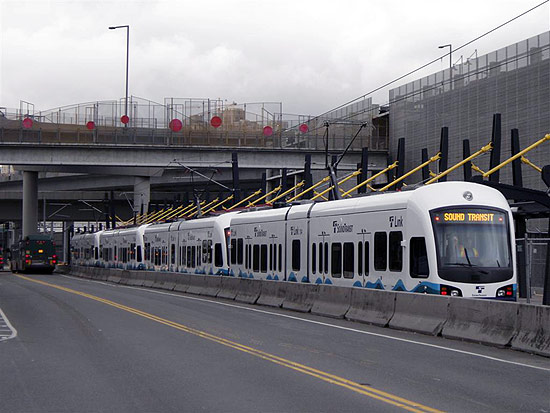
The route also crosses 18 streets at grade, perhaps the most controversial aspect of the project.
Surface stations are easy for pedestrians to reach. And construction is cheaper than elevated or underground lines.
But opponents ask: Why have Washington taxpayers invested millions to separate freight trains from cars with overpasses and underpasses elsewhere while Sound Transit is adding more at-grade crossings?
Sound Transit's environmental studies predict 29 accidents per year between trains and motor vehicles.
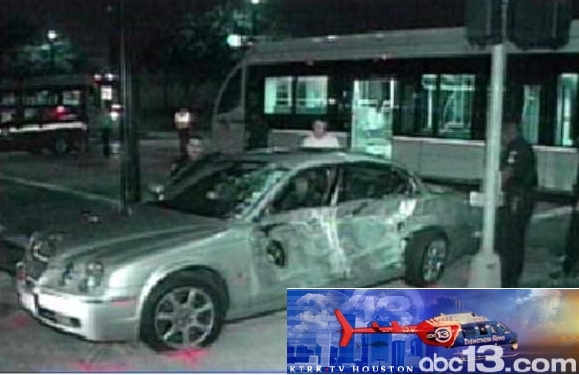 |
The result of a collision between a car and a light rail vehicle in Houston, Texas, June 2004. There were more than 40 collisions of trains and cars in the first six months of operation of Houston Metro Light Rail. From Houston TV Channel 13, KTRK, http://www.abc13.com. |
|
Experience with street-running light rail trains in Houston and Denver has shown that many accidents are the result of mixing street trains with cars.. The Rocky Mountain News in Denver on July 3, 2004 published an extensive historical review of light rail collisions along Denver's T-REX light rail, and found that ungated crossings are the most dangerous locations. The full story is posted here. As is typical, every single accident, over 300 of them, were blamed on car drivers who did not obey traffic control signals, or who otherwise did not provide the train with its legal right-of-way.. |
Here is an example
of a spectacular collision of a train in June 2012 with a truck where nobody was
hurt. Picture taken by Sound Transit.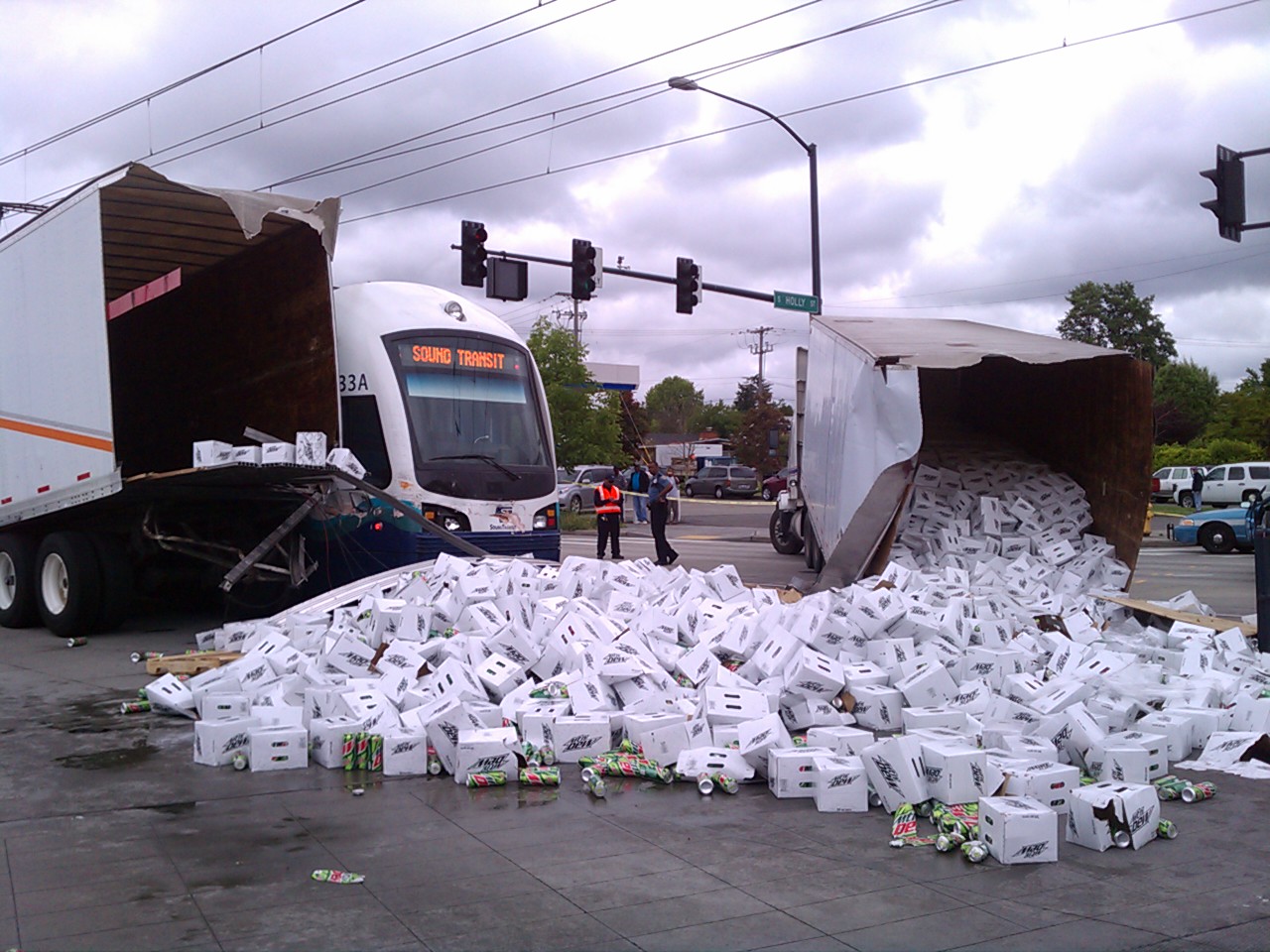
Following picture is a composite of a KIRO TV news photo shot from its helicopter overlaid on Google maps satellite view of the accident site. Commentary later from the Sound Transit Deputy CEO confirmed that the truck was making a U-Turn when it was struck.
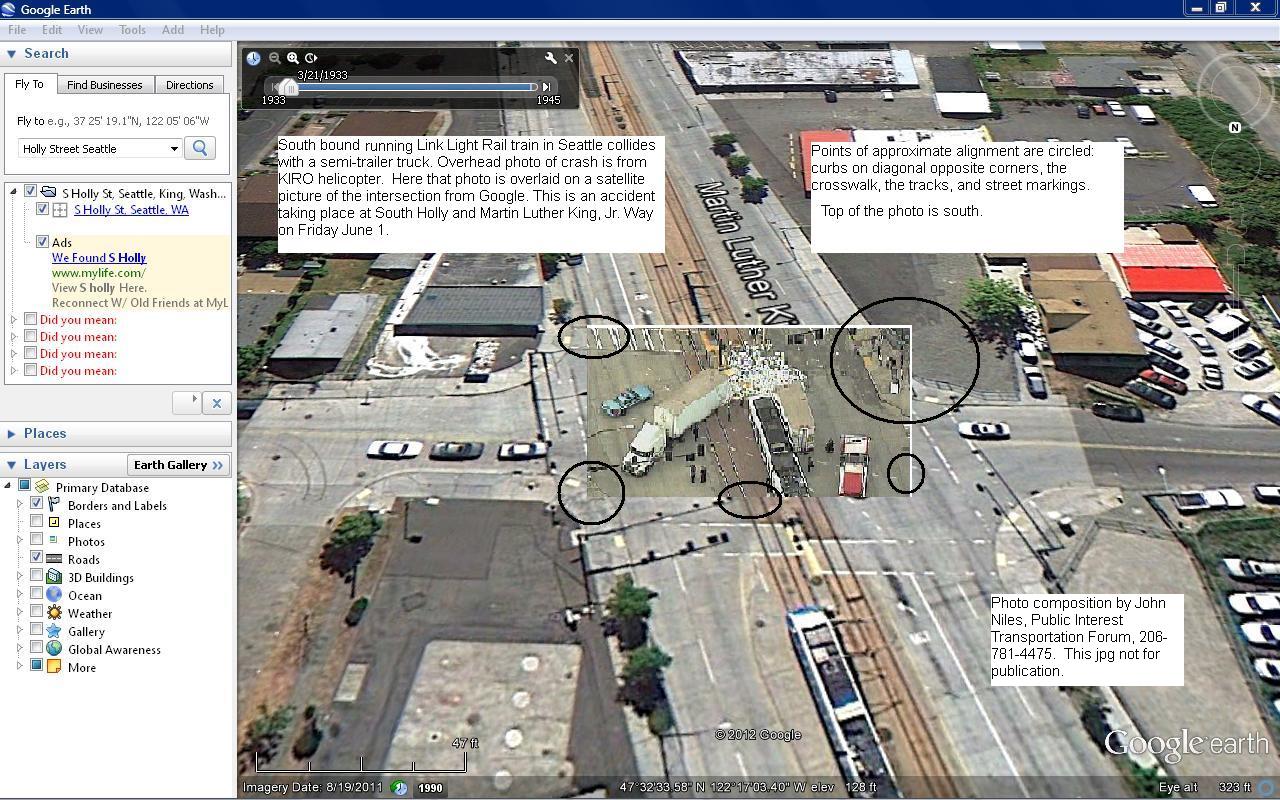
![]() Review some
interesting and relevant information from "outside the box" on the safety of
complex systems (like mixing trains with cars, buses, and trucks):
"Learning From Accidents and a Terrorist Attack" by Dan Bricklin
Review some
interesting and relevant information from "outside the box" on the safety of
complex systems (like mixing trains with cars, buses, and trucks):
"Learning From Accidents and a Terrorist Attack" by Dan Bricklin
Detailed commentary comes next. Click here for Resource Links at the bottom of this page.
![]()
On February 27, March 27, April 10, and May 22, 2003, I presented testimony on behalf of the Coalition for Effective Transportation Alternatives (CETA) to the Sound Transit Board on the problems Sound Transit has in claiming to be certifying the safety of the at-grade road crossings of the Central Link Initial Segment.
An archive of this testimony is at the bottom of this page.
Because of the role of Congress in reviewing Federal funding for Link Initial Segment, CETA prepared a Report to Congress on May 15, 2003 that among other topics describes the intermodal collision issue. That report is posted full text in pdf at the CETA web site, http://www.effectivetransportation.org.
Because trains are so much heavier than cars or even buses, using taxpayer dollars to build new opportunities for trains and motor vehicles to collide by accident is a bad idea. Also, even ignoring occasional collisions, trains can block roads, and road vehicles can block light rail train tracks, at points where the tracks meet the road.
The emerging focus for Link Light Rail Safety lies in whether Sound Transit is
considered to be responsible for accidents and fatalities that are inevitably going to
occur because of the design chosen by Sound Transit for the system. Sound Transit
and Federal Transit Administration claim that collisions caused by driver error in the
face of warning signs and signals are not "chargeable" to Sound Transit, even
though grade separation and operational separation of rail and motor vehicle modes would
completely prevent accidents of this type by making intermodal collisions impossible.
The Central Link design problems lie in the 18 ungated motor vehicle grade crossings
planned for the Rainier Valley (map from Sound Transit),
and also in the legal and illegal opportunities for pedestrians to cross the grade-level
twin tracks. The operating plan in the Environmental Assessment shows that there
will be 272 trains per day moving through these crossings. The system will start
with two-car trains, but four-car trains approximately 360 feet in length are planned.
There is a Quicktime video simulated animation of four car trains on the
Sound
Transit web site accessible by clicking here.
Potential problems also arise in the crossings and shared guideway in the Downtown Seattle
Transit Tunnel, or Bus Tunnel, where the multi-mode mixture of buses and trains is a
unique design creating some uncertainty about safety (diagrams of Tunnel merge points for
buses and trains, from Sound Transit, pdf format). The light rail design for the
Tunnel includes a shared right of way for buses and trains, a facility that in 2010 peak
periods is planned to see 60 buses and 10 trains per hour intermixed in each direction
under signal-assisted human control. A merge point at each end of the tunnel provides an
opportunity for the buses to cross the path of oncoming trains. DSTT safety for mixed
trains and buses has been audited by the US DOT Office of Inspector General, with a report
made on July 7, 2003. Here is what the Inspector General reported on the collision
hazard in the DSTT:
In August 2002, Sound Transit completed a hazards analysis using FTA’s "Hazard Analysis Guidelines for Transit Projects" to identify risks associated with joint bus and light rail operations in the Downtown Seattle Transit Tunnel. Sound Transit’s analysis evaluated the tunnel facilities, equipment, and operating plan to determine the type, frequency, and severity of potential hazards. The analysis identified fires and vehicle collisions as major hazards, but determined that the probability of these events occurring was very low.To address these hazards, Sound Transit developed plans to retrofit the transit tunnel with specific safety improvements. These improvements include fire suppression, collision avoidance, ventilation and evacuation features. Our review found that Sound Transit’s plans, which were 60 percent complete at the time of this review, reasonably addressed safety hazards and other risks associated with tunnel operations....
With respect to vehicle collisions, Sound Transit plans to incorporate traffic control mechanisms in the joint operations plan to maintain safe separation between trains and buses. These traffic controls include an integrated signal system designed to allow only one mode (bus or rail) in a tunnel segment or station at any given time. The provisions to prevent vehicle collisions seem adequate for joint operations and are consistent with transit industry guidelines.
Nonetheless, the reliability of the collision prevention measures will ultimately depend on thorough testing of the controls and signal system prior to revenue operations. [Italics added.]
The ability of "traffic control mechanisms" to prevent grade crossing collisions does, however, require that sufficient time is available for a train to stop once a bus or other motor vehicle blocking the tracks is detected!
The Inspector General audit did not have safety outside the DSTT within its scope of work, so the audit report made no comment on grade-crossing safety in the Rainier Valley.
I was especially motivated to explore the safety issue after a ride I took on a
relatively new street-running light rail train in Salt Lake City, Utah, summer 2002.
During this trip on a bright summer day, I was looking over the train operator's shoulder
out the front. Watching motorists make left turns in front of this train under what I
presume is state-of-the-art signalized control did not seem to me to be a safe addition to
that urban environment. In fact, that light rail system has killed several people in
collisions in the early years of operation. The dramatic effects of a train hitting a car
are shown in photos available from a 2003 (fortunately, non-fatal) collision on the Utah
light rail, posted on
the CETA web, here.
I am also motivated by the long standing concerns of the Save Our Valley community group
about the safety of the grade level Central Link route through the Rainier Valley in
Seattle. A commentary on the hazards by George
Curtis, President of Save Our Valley, is posted in pdf, here. It's important to
remember that the 100 year vision for light rail in this region includes at-grade tracks
with street crossings in many communities surrounding Seattle.
In response to my testimony of February 27, Sound Transit staff made a presentation to the
Board of Directors on March 27, 2003. The Sound Transit safety manager Hamid
Qaasim asserted that the Federally mandated hazard analysis process has so far revealed
that "the probability of a single system failure resulting in a critical chargeable
accident is once in 131 to 13,000 years." Mr. Qaasim further asserts,
"This meets the FTA Guidelines." The details of the hazard
analysis are not published at this time.
Sound Transit regards some collisions as "not chargeable" to the agency. Given the official right-of-way design decisions made by the Sound Transit Board, the distinction between chargeable and non-chargeable is spurious. It is clear that if the light rail tracks were designed by Sound Transit to be grade separated from motor vehicle roadways, collisions between cars and trains would be impossible. It is further clear that if Sound Transit chose not to mix trains with buses in the Bus Tunnel, then collisions between buses and trains in that Tunnel would be impossible. Therefore, collisions between trains and motor vehicles of any type are certainly "chargeable" to Sound Transit and its light rail design.
Collisions between trains and motor vehicles are hazardous, and may seriously injure and kill people, whether they are "chargeable" or not. When it comes to collisions between trains and other vehicles, the only distinction that counts is between "possible" and "impossible."
Joni Earl, Sound Transit Executive Director, sent an electronic mail message following the Board Meeting that summed up the light rail safety situation in Southeast Seattle, where light rail will run in an urban street median: She wrote, "In the Rainier Valley where light rail will run at grade, Sound Transit is increasing the signalized pedestrian-only crossings on Martin Luther King Jr. Way South from two to 10, increasing the signalized traffic and pedestrian intersections from 12 to 21, and providing 17 dedicated, signalized left-turn pockets. Warning bells, a safety zone, and protective railings will also be provided to increase safety at pedestrian crossings. The improvements for light rail will actually reduce the current number of accidents on Martin Luther King Jr. Way South and will make that corridor safer."
Director Earl's prediction of safety has no support in the environmental record. Safety was last covered in the 1999 Final Environmental Impact Statement. That document states that the addition of new traffic signals and street geometry in association with the light rail trains will reduce the number of vehicle-to-vehicle collisions by 44 per year, and the number of collisions between motor vehicles and pedestrians or cyclists will be reduced by seven annually. The 44 fewer vehicle-to-vehicle collisions is claimed by Sound Transit to be more than ample compensation for the 29 new collisions between trains and motor vehicles. The seven fewer times when vehicles hit pedestrians or cyclists is said to justify the three new annual cases of trains hitting people or cyclists.
However, there is a documented fatality rate for train collisions that exceeds the documented Rainier Valley fatality rate for collisions that only involve motor vehicles. CETA calculates that the historical experience of light rail trains and grade crossings at train speeds planned in the Rainier Valley indicates an expectation of eight fatalities per decade.
This logic of substituting one kind of accident for another kind is a transit industry invention embraced by Sound Transit. The common-sense idea that getting hit by a train may be more serious than being hit by a car is not discussed. The fatality and serious injury rates from the various types of accidents traded-off are not discussed in the EIS.
Furthermore, this kind of trade-off between accident types across modes is not covered in Federal Hazard Analysis Guidelines. There is no authority for adding new dangers to an urban street that are justified by reducing an existing form of danger.
King County Councilman and Sound Transit Board Member Dwight Pelz of Seattle supports the logic that any danger to careless motorists and pedestrians from adding light rail to the Rainier Valley is more than compensated by the forecast of reduced automobile and pedestrian accidents that don't involve trains. He wrote in July 2004 in the Beacon Hill News & South District Journal:
Light rail is projected to decrease the number of accidents along Martin Luther King Jr. Way by six percent, with 18 fewer pedestrian and vehicle accidents annually than between 1994 and 1999.
All of light rail system's vehicle and pedestrian crossings in the Rainier Valley are signalized. Sound Transit has increased the number of signalized pedestrian crossings from two to 10 and the number of signalized traffic intersections from 10 to 21, while providing 17 new left-turn pockets. The light rail tracks are on a raised median separated from other traffic by a curb, allowing pedestrians to pause in the middle of the street. Light rail signals will be integrated with the City's traffic signal system to maximize safety. All these investments will serve to "calm" the frantic traffic on MLK.
Mr. Pelz's calculation of 18 fewer accidents is probably based on the 1999 EIS statistics mentioned above: 44 fewer auto-to-auto collisions and 7 fewer pedestrian or bicycle collisions involving cars, offset by 32 new collisions involving light rail trains. (The arithmetic of 44 plus 7 minus 32 yields 19 fewer, not 18.)
To repeat, however, new train collisions are not compensated by reducing non-train collisions -- not logically, and not legally.
And counter to Mr. Pelz's conclusion about traffic calming, there is nothing "calm" about 272 trains per day at 35 mph down the middle of the street.
The new risks to human life stemming from the light rail grade crossing design in the Rainier Valley and in the planned joint bus-rail operations in the downtown Seattle Bus Tunnel would clearly be rated "unacceptable" in a safety certification process carried out by objective analysts. This finding would come from considering the difference in weight between trains and rubber-tire vehicles, the nationwide historical experience of inevitable collisions at grade crossings in urban settings, and the results of those collisions.
 "Unacceptable"
versus "acceptable" has nothing to do with whether the public thinks the risk is
worth the benefit of having trains. There are absolute government and professional
standards that are not related to system benefits. The Federal standard applying to
Seattle's light rail is to build a system sufficiently safe to create an expectation that
there will be no more than one death in one million operating hours. (Sound Transit
translates this many operating hours to 131 years.) There are no design compromises
authorized to cause this standard to be relaxed.
"Unacceptable"
versus "acceptable" has nothing to do with whether the public thinks the risk is
worth the benefit of having trains. There are absolute government and professional
standards that are not related to system benefits. The Federal standard applying to
Seattle's light rail is to build a system sufficiently safe to create an expectation that
there will be no more than one death in one million operating hours. (Sound Transit
translates this many operating hours to 131 years.) There are no design compromises
authorized to cause this standard to be relaxed.
At right is the cover of the Federal guidelines that set the hazard standards for light rail systems. Click the cover to access them in full text (pdf).
The word "chargeable" -- as in "chargeable accident" -- is nowhere to be found in this publication. These guidelines do state, however: "Unacceptable and undesirable risk will be reduced to an acceptable level before design acceptance, or a decision must be made to dispose of the system."
As I said in my testimony to the Sound Transit Board on February 27, 2003, the danger from light rail trains is not to the people riding the trains, but rather to the entire community. Nationwide, the fatality rate per vehicle mile for light rail operations in recent years has been five to ten times higher than for bus transit operations, as shown in this chart:
Document Archive and Resource Links
|
Emory Bundy's essay in Beacon Hill News & South County Journal, June 16, 2004 contrasts official support of constructing new Link Light Rail tracks in urban Rainier Valley with City of Seattle's reaction to accidents on the existing mainline railroad tracks through Golden Gardens Park | |||||||||||||
|
Mike Lindblom's report on Rainier Valley light rail safety in The Seattle Times, April 12th, 2004. | |||||||||||||
|
Archive of public testimony from John Niles, representing CETA, to official government bodies:
|
![]()
Return to the Public Interest Transportation Forum home page.
![]()
Last modified: April 19, 2013